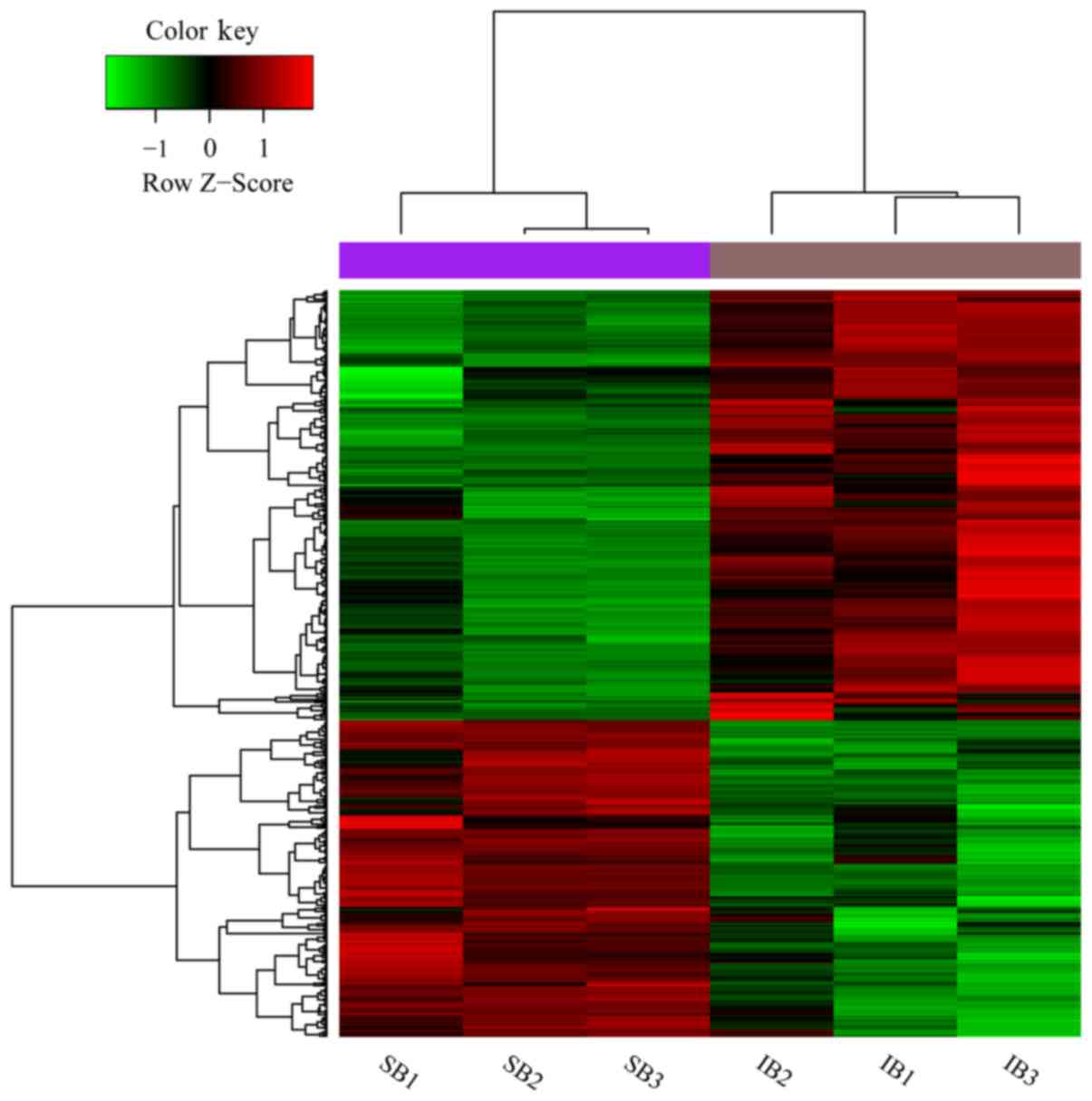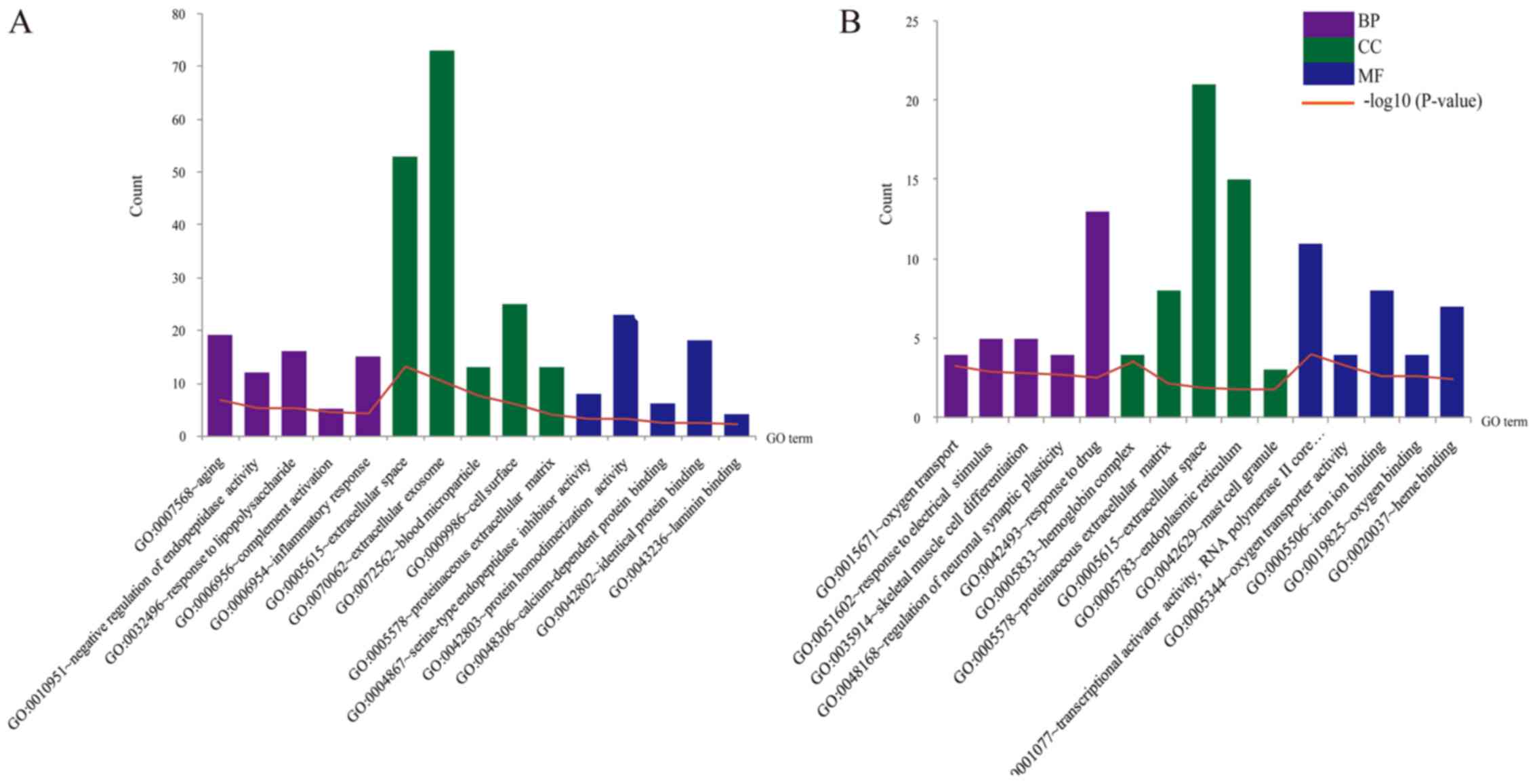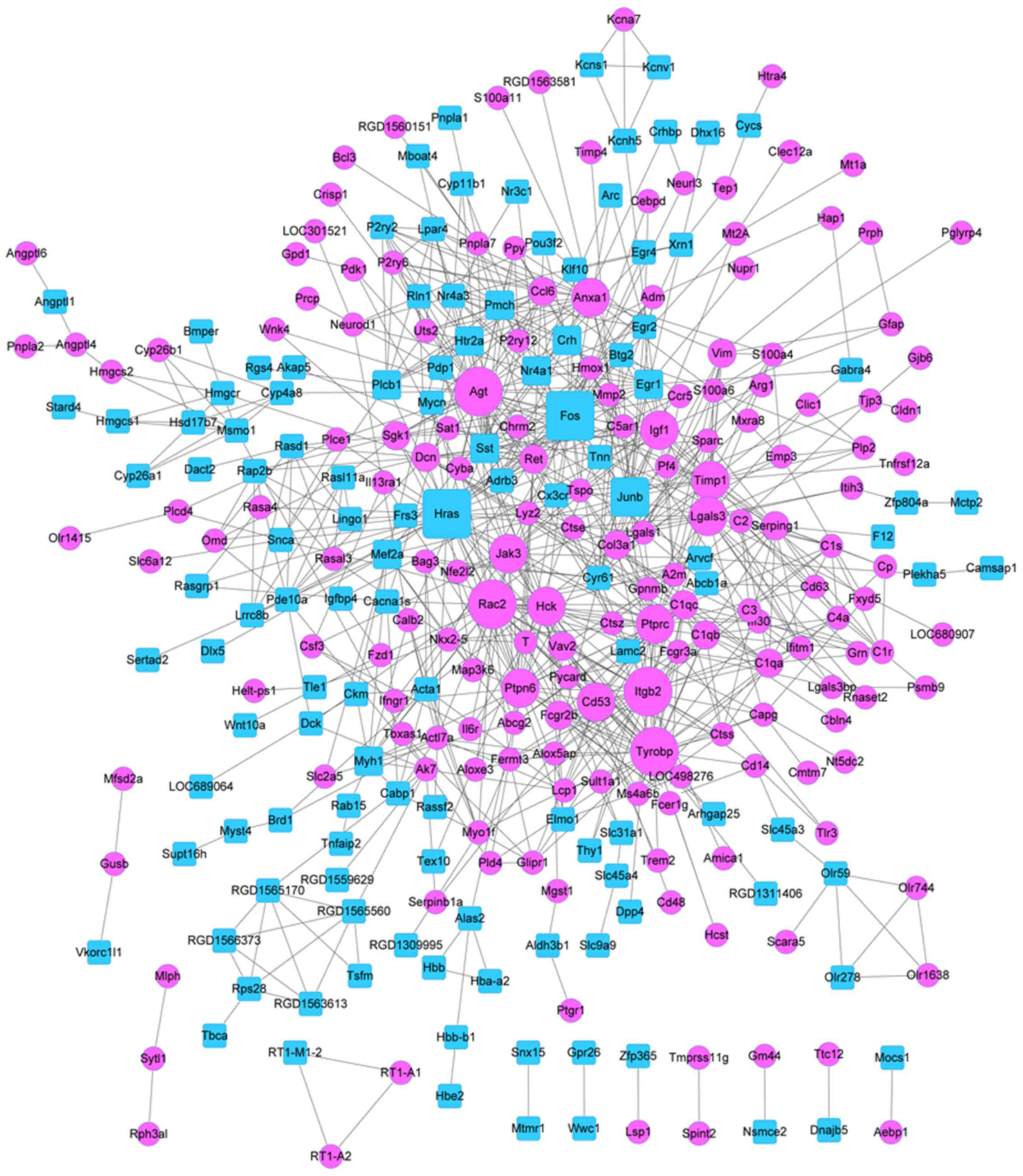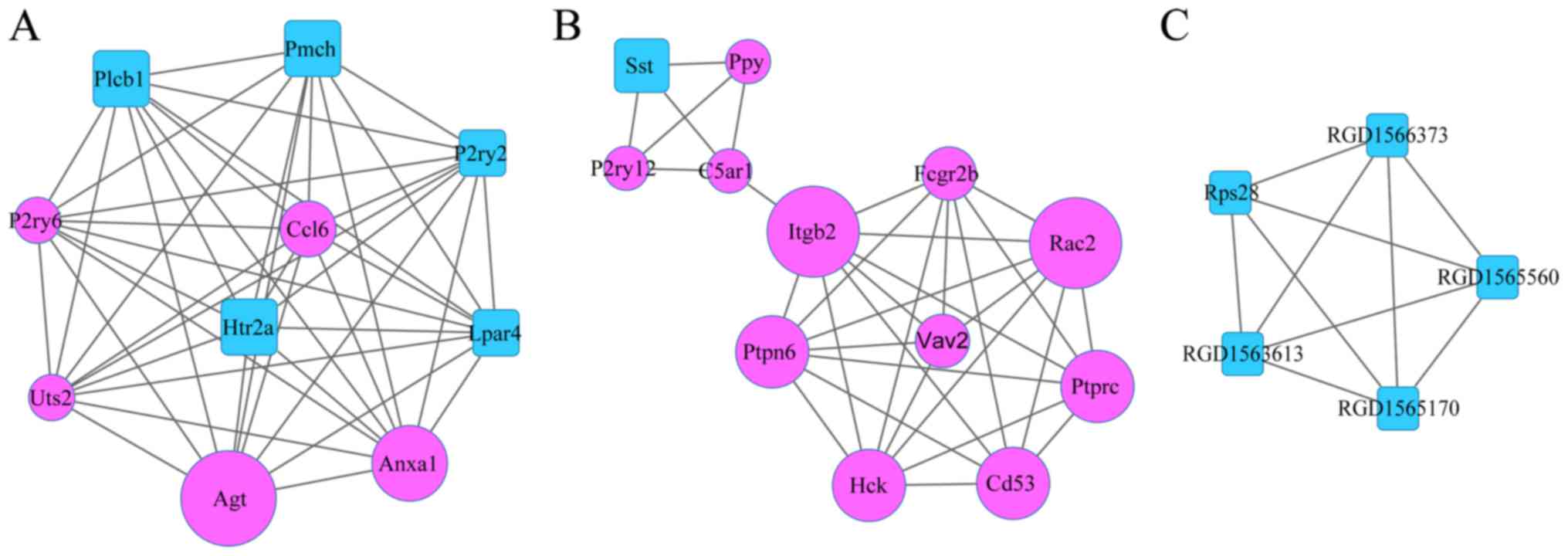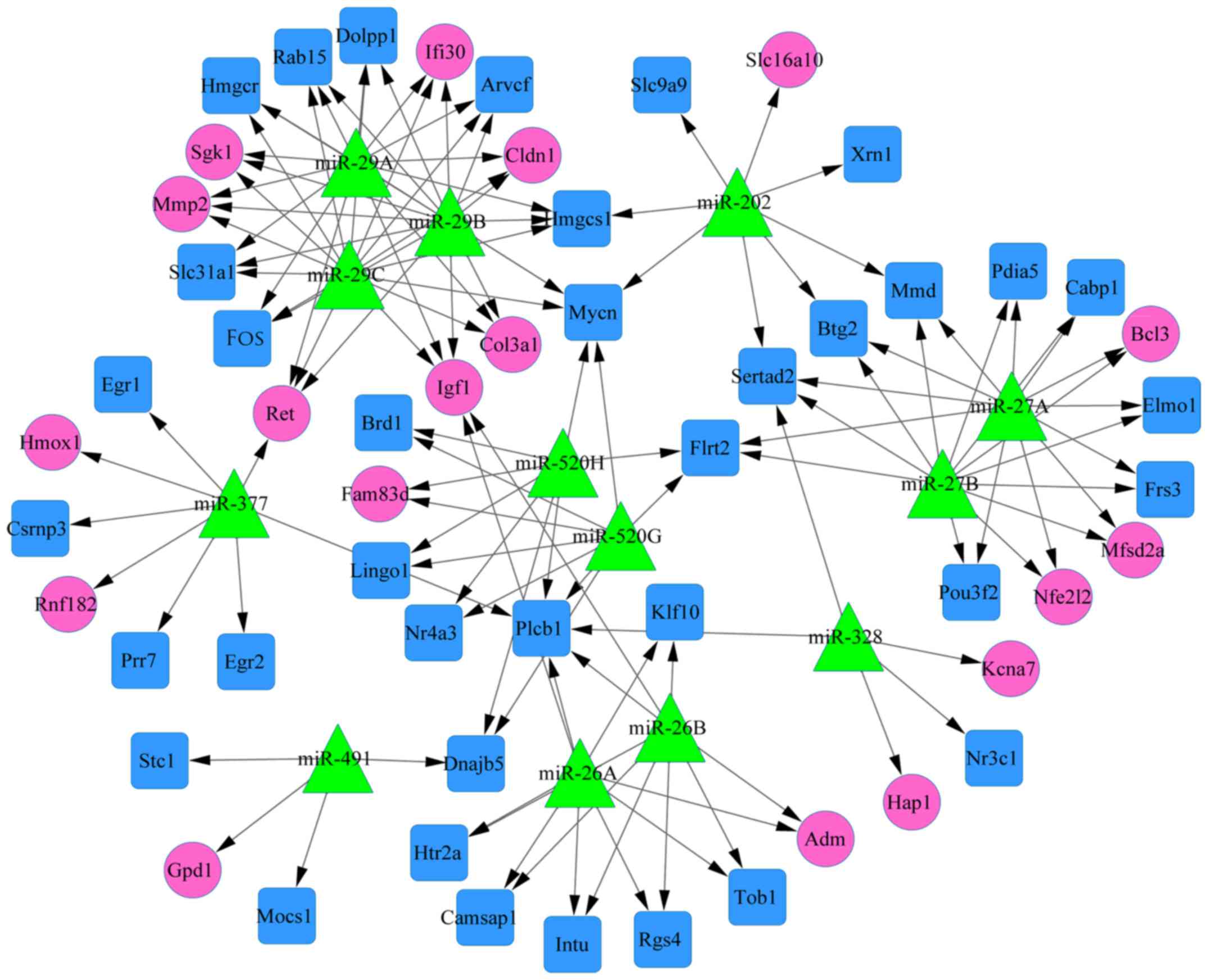Bioinformatics analysis of microarray data to reveal the pathogenesis of brain ischemia
- Authors:
- Published online on: May 9, 2018 https://doi.org/10.3892/mmr.2018.9000
- Pages: 333-341
-
Copyright: © He et al. This is an open access article distributed under the terms of Creative Commons Attribution License.
Abstract
Introduction
Ischemic stroke, the third leading cause of death, leads to neuronal cell death by necrosis or apoptosis, mitochondrial dysfunction, energy depletion, and its complications such as coma, and hemiplegia (1–3). The study shows that the incidence of ischemic stroke decrease over time among men, but it is stable among women (4). It is report that the incidence of ischemic stroke is 170/100 thousand in adult women (5,6), and it is 212/100 thousand in men. Notably, the incidence of ischemic stroke is 91.3/100 thousand-263.1/100 thousand in China (7). Usually, the middle cerebral artery is related to ischemic stroke (8). Despite some clot lysing drugs have applied to ameliorate cerebral ischemic according to clinical experience, the treatment efficacy is limited by the narrow therapeutic safety and time window (1,9). In addition, reperfusion also aggravates brain injury, such as neuronal apoptosis, reactive oxygen species overproduction, and neuro-inflammation (10,11). Thus, it is critical to explore the novel therapeutic agents and targets of ischemic stroke.
Currently, numerous studies involved the pathophysiological of ischemic stroke are performed. For example, the Janus kinase 2/signal transducer and activator of transcription 3 (JAK2/STAT3) signaling pathway is suggested to play a vital role in central nervous system (12). In this pathway, hypoxia preconditioning (13), rhEPO (14), IL-6 (15) can activate JAK2-STAT3 pathway and promote neurological recovery (13,16). In addition, the suppressor of cytokine signaling (SOCS) family of proteins, including SOCS1 and SOCS3, can suppress cytokine activity by interacting with JAK (17), indicating JAK2/STAT3 pathway is associated with cerebral ischemia reperfusion injury. Moreover, studies show that Rac family small GTPase 2 (Rac2), a well-studied small GTPase, has the effect on hematopoietic and endothelial cell integrin and immunoreceptor signaling (18,19). Joshi et al demonstrate that Rac2 is related to macrophage autonomous process, which can control tumor growth (20). However, the relationship between Rac2 and cerebral ischemia need to be further investigated.
MicroRNA (miRNA), a small non-coding RNA molecule, has important functions in the RNA silencing and post-transcriptional regulation of gene expression (21). The study shows that miRNAs are involved in neuro protection, ischemia, and injury (21). Previous study indicated that miR-29a had the protective effect on reperfusion injury by targeting a pro-apoptotic family member (22). However, potential gene markers related to brain ischemia based on gene or miRNA expression remains unclear.
The GSE52001 is obtained on Agilent Array platform and firstly analyzed by Lai et al (23). However, based on the huge information of gene expression profile, the data about the role of potential gene markers in cerebral ischemia are limited. In the present study, a bioinformatics study was performed based on the microarray data deposited by Lai et al (23). On the basis of differentially expressed gene (DEGs) between sham brain samples (sham group) and cerebral ischemia brain samples (ischemia brain group), the function and pathways analyses were investigated. Protein-protein interaction (PPI) network analysis was also conducted. Then the analysis for potential miRNA-target regulation in the process of glioma was performed. We expected to explore a detailed mechanism of transcriptional regulation in the cerebral ischemia, and provide a novel strategy for cerebral ischemia therapy.
Materials and methods
Microarray data
The gene expression profiling GSE52001 was downloaded from the Gene Expression Omnibus (http://www.ncbi.nlm.nih.gov/geo/) database (24), which was based on the platform of GPL14746 Agilent-028282 Whole Rat Genome Microarray 4×44 K V3.0 expression beadchip. The organism of this dataset was Rattus norvegicus, including 3 normal brain samples (Sham brain, SB, SB1, SB2, SB3) and 3 brain samples of cerebral ischemia (ischemia brain, IB, IB1, IB2, IB3) (23). The IB samples were collected as follows: Male Sprague Dawley rats (220±20 g; 7–8 weeks old) were anesthetized with 10% chloral hydrate (3 ml/kg). Then a silicone-coated nylon monofilament was inserted from the left common carotid artery to the origin of the middle cerebral artery. After 2 h of occlusion, reperfusion was induced by withdrawing the filament. Sham animals were operated on in the same manner except that the middle cerebral artery was not occluded. The animal experiments were conducted in accordance with the guidelines of the National Institutes of Health Guide for the Care and Use of Laboratory Animals. The study of Lai et al was approved by the Animal Care and Use Committee of Fujian University of Traditional Chinese Medicine (23).
Pretreatment and differential analysis
The robust multi-array average (RMA) method in limma package (http://www.bioconductor.org/packages/2.9/bioc/html/limma.html) (25) was applied to preprocess the raw CEL data by performing background correction, data normalization, conversion of original data, and quartile data normalization. Then the DEGs were identified by the non-paired t-test in limma package (25). Here, the adjusted P-value <0.05 and |log fold change (FC) |≥1 were set as the threshold value. Finally, the heat map for DEGs was generated via the Pheatmap package (https://CRAN.R-project.org/package=pheatmap) (26) in R (version 3.3.2).
Functional and pathway enrichment analyses
Gene Ontology (GO) (http://www.geneontology.org) analysis (27) is used for analyzing the functions of a large number of genes. The Kyoto Encyclopedia of Genes and Genomes (KEGG, http://www.genome.ad.jp/kegg/) (28,29) pathway is the major recognized pathway-related database which contains varieties of biochemical pathways (29). Multifaceted Analysis Tool for Human Transcriptome (MATHT) (www.biocloudservice.com) was used to perform GO term and KEGG pathway enrichment analyses for the DEGs. The setting of cut-off value was P-value <0.05.
PPI network and module analyses
The Search Tool for the Retrieval of Interacting Genes (STRING) (version 10.0) (30) (http://www.string-db.org/) is an online database providing experimental and predicted PPI information. Here, the STRING database (30) was applied to analyze the PPIs among the proteins encoded by the DEGs. The parameter was set as medium confidence score >0.4. Then the PPI networks for the upregulated genes and the downregulated genes were separately visualized by Cytoscape software (version 3.2.0) (http://www.cytoscape.org/) (31), and node degrees were determined. In addition, the significant modules were obtained using the MCODE plug-in (http://apps.cytoscape.org/apps/mcode) (32) in Cytoscape software. Additionally, the KEGG pathway enrichment analysis for nodes in the significant modules was performed using MATHT tool.
miRNA-target gene regulatory network analyses
With the discovery of RNA interference (RNAi), the function of noncoding RNAs in gene expression and regulation was widely focused (33). MiRNAs regulate the expression of genes by interacting with their target genes at the post transcription stage (33). In the present study, the miRNAs associated with DEGs were searched utilizing WebGestal (http://www.webgestalt.org/option.php) (34,35) online tool, and miRNA-DEG regulatory network was visualized by Cytoscape software (31).
Results
DEGs and clusters
In total, 488 DEGs were identified, including 281 upregulated and 207 downregulated DEGs. Thereafter, the 488 DEGs and 6 samples were clustered, and DEGs could well differentiate the IB samples from the SB controls (Fig. 1).
Functional and pathway enrichment analyses
The enriched GO terms and KEGG pathways for DEGs were identified. According to the P-values (ascending sort), the top 5 enriched terms were exhibited in Fig. 2. The upregulated genes were significantly enriched in the functions of aging (BP, P=1.69×10−7), extracellular exosome (CC, P=3.58×10−11), extracellular space (CC, P=5.70×10−14), protein homodimerization activity (MF, P=6.23×10−4), and identical protein binding (MF, P=3.80×10−3) (Fig. 2A). While the downregulated genes were dramatically enriched in the functions of response to drug (BP, P=3.20×10−3), extracellular space (CC, P=1.25×10−2), transcriptional activator activity (MF, P=1.03×10−4), and RNA polymerase II core promoter proximal region sequence-specific binding (MF, P=1.03×10−4) (Fig. 2B). Besides, the significantly enriched KEGG pathways were presented in Table I. For the upregulated genes, the significantly enriched KEGG pathways mainly include staphylococcus aureus infection (pathway, P=8.15×10−10), pertussis (pathway, P=2.64×10−7), and complement and coagulation cascades (pathway, P=2.36×10−6). There were only 2 significantly enriched KEGG pathways for the downregulated genes, which include African trypanosomiasis and Aldosterone synthesis (pathway, P=4.70×10−3), and secretion (pathway, P=3.96×10−2) (Table I).
PPI network and module analyses
The PPI network with 295 nodes and 827 edges was constructed (Fig. 3). Upregulated gene with higher node degree were Rac2, angiotensinogen (Agt), integrin β2 (Itgb2), protein tyrosine phosphatase, receptor type, C (Ptprc), protein tyrosine phosphatase, non-receptor type 6 (Ptpn6), and hematopoietic cell kinase (Hck). Downregulated genes with higher degrees were Fos, Hras, and Junb. The degree of top 20 DEGs was listed in the Table II. In this study, 3 significant modules were obtained by MCODE plug-in, which included module A (10 nodes and 45 edges), module B (12 nodes and 33 edges), and module C (5 nodes and 10 edges) (Fig. 4).
Table II.Degree of top 20 differentially-expressed genes in the protein-protein interaction network. |
In addition, 2 KEGG pathways were significantly enriched in module A, including neuroactive ligand-receptor interaction (P=9.62×10−4), and inflammatory mediator regulation of TRP channels (P=3.03×10−3). Meanwhile, 8 KEGG pathways were dramatically enriched in module B, such as FcγR-mediated phagocytosis (P=1.60×10−6), B cell receptor signaling pathway (P=5.40×10−5), and natural killer cell mediated cytotoxicity (P=1.54×10−4) (Table III). However, no pathways were enriched for the nodes in module C.
miRNA-target regulatory network analysis
A total of 58 DEGs, 13 miRNAs, and 128 edges were contained in the miRNA-DEG regulatory network (Fig. 5). The nodes with top 10 degrees were listed in Table IV. Among them, the degrees of miR-29A, miR-29B and miR-29C were higher than other miRNAs in the miRNA-target regulatory network. Besides, target genes with higher degrees such as Mycn, Plcb1, Igf1 were shown in Fig. 5.
Discussion
In the present study, a total of 488 DEGs were identified, including 281 upregulated and 207 downregulated DEGs. Rac2, with higher degree in the PPI network, was associated with FcγR-mediated phagocytosis pathway. In the miRNA-target gene network, the degrees of miR-29A, miR-29B and miR-29C were higher than other miRNAs. Notably, the target gene Igf1 was regulated by miR-29A, miR-29B and miR-29C.
Rac2, a member of Rac sub-class 3 proteins (including Rac1, Rac2 and Rac3), is a well-studied small GTPase (36,37). Among sub-class proteins, there are 92% sequence identity between Rac1 and Rac2, 83% identity between Rac2 and Rac3, and 77% identity between Rac1 and Rac3 (18). Rac2 is only expressed in hematopoietic and endothelial cells, while Rac1 and Rac3 are comprehensively expressed in mammalian systems (36–38). Rac2, the hematopoietic specific GTPase, plays an obligate role in endothelial integrin signaling and the postnatal neovascularization response in vivo (19). Additionally, some studies demonstrated that Rac2 regulates FcγR-mediated phagocytosis (39–41). Consistent with Yang et al (42), this study also shows that RAC2 is related to FcγR-mediated phagocytosis pathway in brain ischemia by bioinformatics methods. Yang et al (42) point that pathological nerve pain may be related to immune dysfunctions. Here, our results showed that RAC2 gene and FcγR-mediated phagocytosis pathway may have vital effect on the progress of pathological nerve pain in nervous system. Therefore, RAC2 may play an important role in the development of brain ischemia by mediating FcγR-mediated phagocytosis pathway.
In recent years, Kriegel et al reveal that the miR-29 family, including miR-29A, miR-29B-1, miR-29B-2 and miR-29C (43), is found to be enriched in astrocytes (44). Previous study also shows that miR-29 family is downregulated in cortex (45), but is upregulated in hippocampus after focal ischemia (46). miR-29A/B-1 is reported in Alzheimer's disease (47). Ouyang et al uncover that miR-29A is significantly upregulated in astrocytes, and regulates ischemic injury by BH3-only protein PUMA (22). The study shows that miR-29B loss at the infarct site is an important contributor to stroke lesion by 12-lipoxygenase pathway (48). Downregulated miR-29C promotes ischemic brain damage by its target gene DNMT3a. REST, an upstream transcriptional controller of miR-29C, can impede miR-29C downregulation and ischemic neuronal death by reducing REST induction (49). In this study, the degrees of miR-29A, miR-29B and miR-29C were higher than other miRNAs in the miRNA-target regulatory network. These results suggest that miR-29A/B/C may be novel biomarkers for the protection of brain ischemia injury. Intriguingly, these results were also in accordance with previous studies (22,48,49). In addition, our results indicated that miR-29A/B/C regulated the upregulated target gene Igf1 in brain ischemia. Nicholas et al find that Igf1 and Il1RAP are direct targets of miR-29 in biliary atresia (50). Therefore, we speculated that Igf1 targeted by miR-29A/B/C may have significant effect in brain ischemia. However, the detailed regulatory relationship between Igf1 and miR-29A/B/C in brain ischemia is not validated.
In conclusion, this study indicated that RAC2 may function in brain ischemia through the FcγR-mediated phagocytosis pathway. Meanwhile, miR-29A/B/C and their target gene Igf1 may have critical roles in brain ischemia. This study provides new insights into the molecular mechanisms for the progression of brain ischemia and suggests directions for future study. However, it is essential for verifying these results by the experiment in the future.
Acknowledgements
Not applicable.
Funding
This study was supported by the National Natural Science Foundation of China (grant no. 81270435).
Availability of data and materials
The datasets used and/or analyzed during the present study are available from the corresponding author on reasonable request.
Authors' contributions
JH and YG conceived and designed the research. YZ acquired the data. WP, GW and XL analyzed and interpreted the data. JH and HY performed the statistical analysis. YG obtained the funding. JH drafted the manuscript. YG, GW and XL revised the manuscript. All authors have read and approved the final manuscript.
Ethics approval and consent to participate
The animal experiments were conducted in accordance with the guidelines of the National Institutes of Health Guide for the Care and Use of Laboratory Animals. The study of Lai et al was approved by the Animal Care and Use Committee of Fujian University of Traditional Chinese Medicine.
Consent for publication
Not applicable.
Competing interests
The authors declare that they have no competing interest.
References
|
Muresanu DF, Buzoianu A, Florian SI and von Wild T: Towards a roadmap in brain protection and recovery. J Cell Mol Med. 16:2861–2871. 2012. View Article : Google Scholar : PubMed/NCBI | |
|
Hankey GJ: Anticoagulant therapy for patients with ischaemic stroke. Nat Rev Neurol. 8:319–328. 2012. View Article : Google Scholar : PubMed/NCBI | |
|
Klimkiewicz P, Kubsik A and Woldańska-Okońska M: NDT-Bobath method used in the rehabilitation of patients with a history of ischemic stroke. Wiad Lek. 65:102–107. 2012.(In Polish). PubMed/NCBI | |
|
Malki N, Koupil I, Eloranta S, Weibull CE, Tiikkaja S, Ingelsson E and Sparén P: Temporal trends in incidence of myocardial infarction and ischemic stroke by socioeconomic position in Sweden 1987–2010. PLoS One. 9:e1052792014. View Article : Google Scholar : PubMed/NCBI | |
|
Sherzai AZ, Ma H, Hornross P, Canchola AJ, Voutsinas J, Willey JZ, Gu Y, Scarmeas N, Sherzai D, Bernstein L, et al: Abstract MP85: Mediterranean diet and incidence of stroke in the California teachers study. Circulation. 131:AMP85. 2015. | |
|
Khoury JC, Kissela B, Sucharew H, Alwell K, Moomaw C, Woo D, Flaherty M, Adeoye O, Khatri P, Ferioli S, et al: Abstract 145: Is the rate of ischemic stroke incidence changing differentially over time for women and men? In: American-Heart-Association/American-Stroke-Association International. Stroke. 44 Suppl 1:A1452013. | |
|
Tu XS: Epidemiological studies of acute ischemic stroke. Chin J Clin Neurosci. 24:594–599. 2016. | |
|
Li L, Li H and Li M: Curcumin protects against cerebral ischemia-reperfusion injury by activating JAK2/STAT3 signaling pathway in rats. Int J Clin Exp Med. 8:14985–14991. 2015.PubMed/NCBI | |
|
Yepes M, Roussel BD, Ali C and Vivien D: Tissue-type plasminogen activator in the ischemic brain: More than a thrombolytic. Trends Neurosci. 32:48–55. 2009. View Article : Google Scholar : PubMed/NCBI | |
|
Yang Y, Jiang S, Dong Y, Fan C, Zhao L, Yang X, Li J, Di S, Yue L, Liang G, et al: Melatonin prevents cell death and mitochondrial dysfunction via a SIRT1-dependent mechanism during ischemic-stroke in mice. J Pineal Res. 58:61–70. 2015. View Article : Google Scholar : PubMed/NCBI | |
|
Palencia G, Medrano JÁ, Ortiz-Plata A, Farfán DJ, Sotelo J, Sánchez A and Trejo-Solís C: Anti-apoptotic, anti-oxidant, and anti-inflammatory effects of thalidomide on cerebral ischemia/reperfusion injury in rats. J Neurol Sci. 351:78–87. 2015. View Article : Google Scholar : PubMed/NCBI | |
|
Nicolas CS, Amici M, Bortolotto ZA, Doherty A, Csaba Z, Fafouri A, Dournaud P, Gressens P, Collingridge GL and Peineau S: The role of JAK-STAT signaling within the CNS. JAKSTAT. 2:e229252013.PubMed/NCBI | |
|
Wang G, Zhou D, Wang C, Gao Y, Zhou Q, Qian G and Decoster MA: Hypoxic preconditioning suppresses group III secreted phospholipase A2-induced apoptosis via JAK2-STAT3 activation in cortical neurons. J Neurochem. 114:1039–1048. 2010.PubMed/NCBI | |
|
Zhou TF and Yu JG: Recombinant human erythropoietin attenuates neuronal apoptosis and cognitive defects via JAK2/STAT3 signaling in experimental endotoxemia. J Surg Res. 183:304–312. 2013. View Article : Google Scholar : PubMed/NCBI | |
|
Feng Q, Wang YI and Yang Y: Neuroprotective effect of interleukin-6 in a rat model of cerebral ischemia. Exp Ther Med. 9:1695–1701. 2015. View Article : Google Scholar : PubMed/NCBI | |
|
Zhu H, Zou L, Tian J, Du G and Gao Y: SMND-309, a novel derivative of salvianolic acid B, protects rat brains ischemia and reperfusion injury by targeting the JAK2/STAT3 pathway. Eur J Pharmacol. 714:23–31. 2013. View Article : Google Scholar : PubMed/NCBI | |
|
Yasukawa H, Misawa H, Sakamoto H, Masuhara M, Sasaki A, Wakioka T, Ohtsuka S, Imaizumi T, Matsuda T and Ihle JN: The JAK-binding protein JAB inhibits Janus tyrosine kinase activity through binding in the activation loop. EMBO J. 18:1309–1320. 1999. View Article : Google Scholar : PubMed/NCBI | |
|
Pradip D, Peng X and Durden DL: Rac2 specificity in macrophage integrin signaling: Potential role for Syk kinase. J Biol Chem. 278:41661–14669. 2003. View Article : Google Scholar : PubMed/NCBI | |
|
De P, Peng Q, Traktuev DO, Li W, Yoder MC, March KL and Durden DL: Expression of RAC2 in endothelial cells is required for the postnatal neovascular response. Exp Cell Res. 315:248–263. 2009. View Article : Google Scholar : PubMed/NCBI | |
|
Joshi S, Singh AR, Zulcic M, Bao L, Messer K, Ideker T, Dutkowski J and Durden DL: Rac2 controls tumor growth, metastasis and M1-M2 macrophage differentiation in vivo. PLoS One. 9:e958932014. View Article : Google Scholar : PubMed/NCBI | |
|
Saugstad JA: MicroRNAs as effectors of brain function with roles in ischemia and injury, neuroprotection, and neurodegeneration. J Cereb Blood Flow Metab. 30:1564–1576. 2010. View Article : Google Scholar : PubMed/NCBI | |
|
Ouyang YB, Xu L, Lu Y, Sun X, Yue S, Xiong XX and Giffard RG: Astrocyte-enriched miR-29a targets PUMA and reduces neuronal vulnerability to forebrain ischemia. Glia. 61:1784–1794. 2013. View Article : Google Scholar : PubMed/NCBI | |
|
Lai W, Zheng Z, Zhang X, Wei Y, Chu K, Brown J, Hong G and Chen L: Salidroside-mediated neuroprotection is associated with induction of early growth response genes (Egrs) across a wide therapeutic window. Neurotox Res. 28:108–121. 2015. View Article : Google Scholar : PubMed/NCBI | |
|
Barrett T, Suzek TO, Troup DB, Wilhite SE, Ngau WC, Ledoux P, Rudnev D, Lash AE, Fujibuchi W and Edgar R: NCBI GEO: Mining millions of expression profiles-database and tools. Nucleic Acids Res. 33:D562–D566. 2005. View Article : Google Scholar : PubMed/NCBI | |
|
Smyth GK: Limma: Linear Models for Microarray DataBioinformatics and Computational Biology Solutions Using R and Bioconductor. Gentleman R, Carey VJ, Huber W, Irizarry RA and Dudoit S: Springer; New York, NY: pp. 397–420. 2005, View Article : Google Scholar | |
|
Kolde R: Pheatmap: Pretty HeatmapsR Package. Version 0.7. 7. CRAN Repository; 2012 | |
|
Ashburner M, Ball CA, Blake JA, Botstein D, Butler H, Cherry JM, Davis AP, Dolinski K, Dwight SS, Eppig JT, et al: Gene ontology: Tool for the unification of biology. The Gene Ontology Consortium. Nat Genet. 25:25–29. 2000. View Article : Google Scholar : PubMed/NCBI | |
|
Kanehisa M and Goto S: KEGG: Kyoto Encyclopedia of Genes and Genomes. Nucleic Acids Res. 28:27–30. 2000. View Article : Google Scholar : PubMed/NCBI | |
|
Du J, Yuan Z, Ma Z, Song J, Xie X and Chen Y: KEGG-PATH: Kyoto encyclopedia of genes and genomes-based pathway analysis using a path analysis model. Mol Biosyst. 10:2441–2447. 2014. View Article : Google Scholar : PubMed/NCBI | |
|
Szklarczyk D, Franceschini A, Wyder S, Forslund K, Heller D, Huerta-Cepas J, Simonovic M, Roth A, Santos A, Tsafou KP, et al: STRING v10: PRotein-protein interaction networks, integrated over the tree of life. Nucleic Acids Res. 43:(Database Issue). D447–D452. 2015. View Article : Google Scholar : PubMed/NCBI | |
|
Shannon P, Markiel A, Ozier O, Baliga NS, Wang JT, Ramage D, Amin N, Schwikowski B and Ideker T: Cytoscape: A software environment for integrated models of biomolecular interaction networks. Genome Res. 13:2498–2504. 2003. View Article : Google Scholar : PubMed/NCBI | |
|
Bandettini WP, Kellman P, Mancini C, Booker OJ, Vasu S, Leung SW, Wilson JR, Shanbhag SM, Chen MY and Arai AE: MultiContrast Delayed Enhancement (MCODE) improves detection of subendocardial myocardial infarction by late gadolinium enhancement cardiovascular magnetic resonance: A clinical validation study. J Cardiovasc Magn Reson. 14:832012. View Article : Google Scholar : PubMed/NCBI | |
|
Slezak-Prochazka I, Durmus S, Kroesen BJ and van den Berg A: MicroRNAs, macrocontrol: Regulation of miRNA processing. RNA. 16:1087–1095. 2010. View Article : Google Scholar : PubMed/NCBI | |
|
Wang J, Duncan D, Shi Z and Zhang B: WEB-based GEne SeT AnaLysis Toolkit (WebGestalt): update 2013. Nucleic Acids Res. 41:W77–W83. 2013. View Article : Google Scholar : PubMed/NCBI | |
|
Zhang B, Kirov S and Snoddy J: WebGestalt: An integrated system for exploring gene sets in various biological contexts. Nucleic Acids Res. 33:W741–W748. 2005. View Article : Google Scholar : PubMed/NCBI | |
|
Didsbury J, Weber RF, Bokoch GM, Evans T and Snyderman R: rac, a novel ras-related family of proteins that are botulinum toxin substrates. J Biol Chem. 264:16378–16382. 1989.PubMed/NCBI | |
|
Haataja L, Groffen J and Heisterkamp N: Characterization of RAC3, a novel member of the Rho family. J Biol Chem. 272:20384–20388. 1997. View Article : Google Scholar : PubMed/NCBI | |
|
Diekmann D, Nobes CD, Burbelo PD, Abo A and Hall A: Rac GTPase interacts with GAPs and target proteins through multiple effector sites. EMBO J. 14:5297–5305. 1995.PubMed/NCBI | |
|
Ueyama T, Eto M, Kami K, Tatsuno T, Kobayashi T, Shirai Y, Lennartz MR, Takeya R, Sumimoto H and Saito N: Isoform-specific membrane targeting mechanism of Rac during Fc gamma R-mediated phagocytosis: Positive charge-dependent and independent targeting mechanism of Rac to the phagosome. J Immunol. 175:2381–2390. 2005. View Article : Google Scholar : PubMed/NCBI | |
|
Yamauchi A, Li SJ, Marchal CC and Dinauer MC: Rac2-null macrophages have defects in superoxide production and Fc gamma-R-mediated phagocytosis. Blood. 100:17722002. | |
|
Patel JC, Hall A and Caron E: Vav regulates activation of Rac but not Cdc42 during FcgammaR-mediated phagocytosis. Mol Biol Cell. 13:1215–1226. 2002. View Article : Google Scholar : PubMed/NCBI | |
|
Yang YK, Lu XB, Wang YH, Yang MM and Jiang DM: Identification crucial genes in peripheral neuropathic pain induced by spared nerve injury. Eur Rev Med Pharmacol Sci. 18:2152–2159. 2014.PubMed/NCBI | |
|
Kriegel AJ, Liu Y, Fang Y, Ding X and Liang M: The miR-29 family: Genomics, cell biology, and relevance to renal and cardiovascular injury. Physiol Genomics. 44:237–244. 2012. View Article : Google Scholar : PubMed/NCBI | |
|
Smirnova L, Gräfe A, Seiler A, Schumacher S, Nitsch R and Wulczyn FG: Regulation of miRNA expression during neural cell specification. Eur J Neurosci. 21:1469–1477. 2005. View Article : Google Scholar : PubMed/NCBI | |
|
Dharap A, Bowen K, Place R, Li LC and Vemuganti R: Transient focal ischemia induces extensive temporal changes in rat cerebral microRNAome. J Cereb Blood Flow Metab. 29:675–687. 2009. View Article : Google Scholar : PubMed/NCBI | |
|
Yuan Y, Wang JY, Xu LY, Cai R, Chen Z and Luo BY: MicroRNA expression changes in the hippocampi of rats subjected to global ischemia. J Clin Neurosci. 17:774–778. 2010. View Article : Google Scholar : PubMed/NCBI | |
|
Shioya M, Obayashi S, Tabunoki H, Arima K, Saito Y, Ishida T and Satoh J: Aberrant microRNA expression in the brains of neurodegenerative diseases: miR-29a decreased in Alzheimer disease brains targets neurone navigator 3. Neuropathol Appl Neurobiol. 36:320–330. 2010. View Article : Google Scholar : PubMed/NCBI | |
|
Khanna S, Rink C, Ghoorkhanian R, Gnyawali S, Heigel M, Wijesinghe DS, Chalfant CE, Chan YC, Banerjee J, Huang Y, et al: Loss of miR-29b following acute ischemic stroke contributes to neural cell death and infarct size. J Cereb Blood Flow Metab. 33:1197–1206. 2013. View Article : Google Scholar : PubMed/NCBI | |
|
Pandi G, Nakka VP, Dharap A, Roopra A and Vemuganti R: MicroRNA miR-29c downregulation leading to de-repression of its target DNA methyltransferase 3a promotes ischemic brain damage. PLoS One. 8:e580392013. View Article : Google Scholar : PubMed/NCBI | |
|
Hand NJ, Horner AM, Master ZR, Boateng LA, LeGuen C, Uvaydova M and Friedman JR: MicroRNA profiling identifies miR-29 as a regulator of disease-associated pathways in experimental biliary atresia. J Pediatr Gastroenterol Nutr. 54:186–192. 2012. View Article : Google Scholar : PubMed/NCBI |



